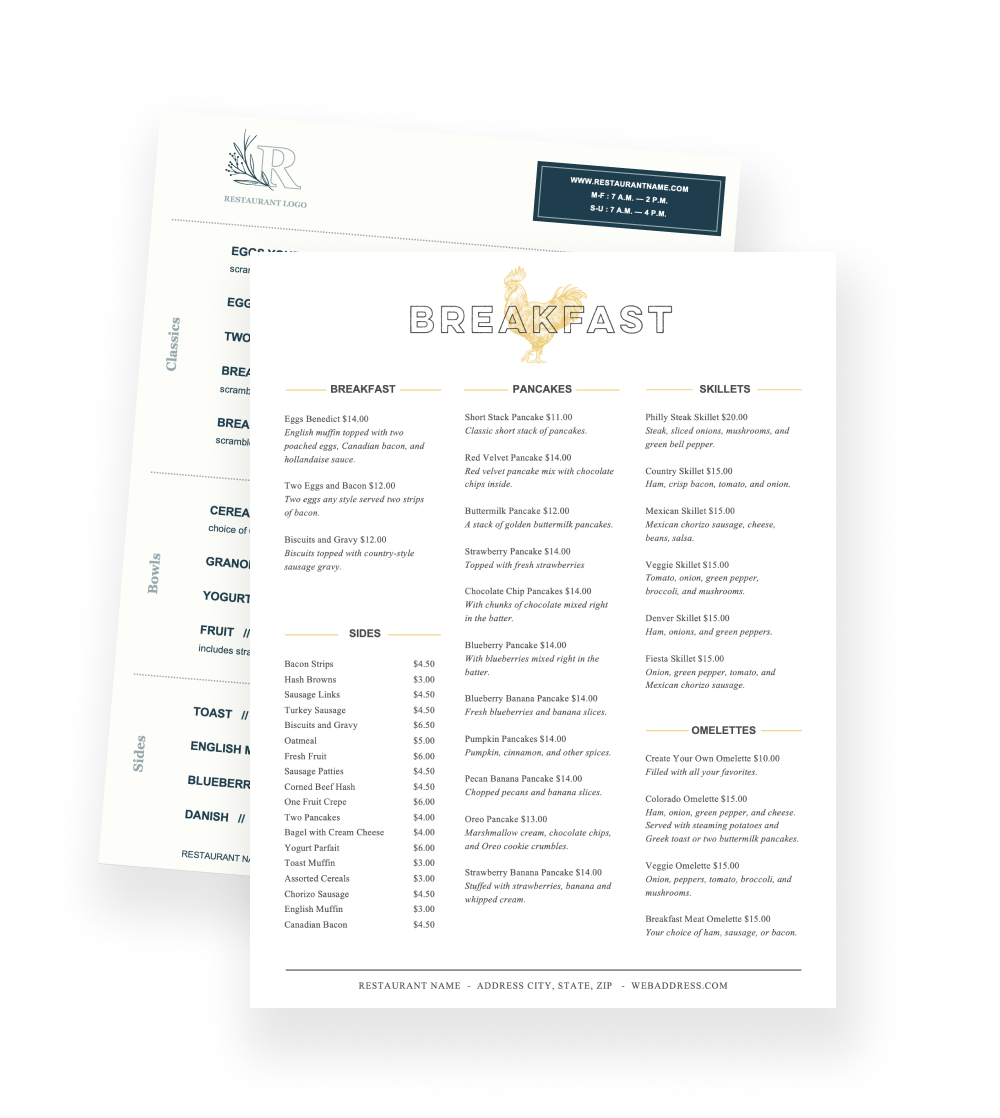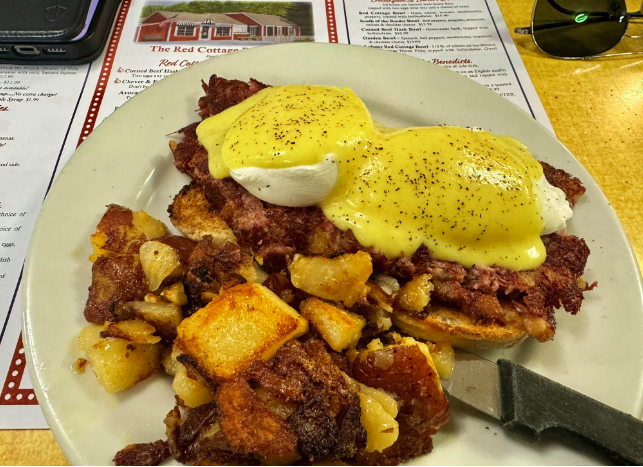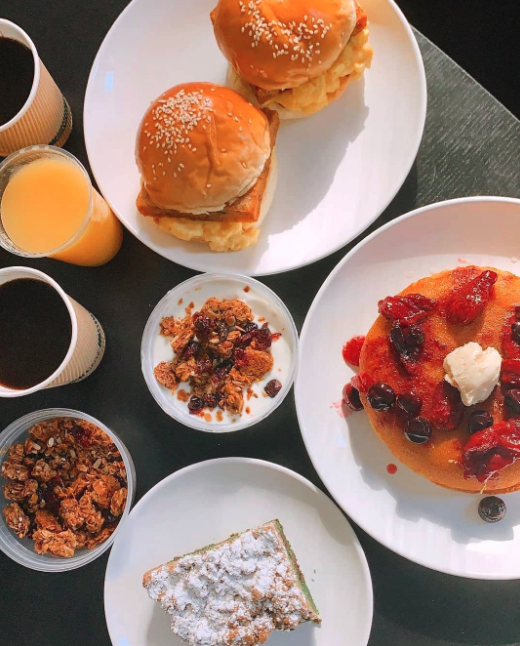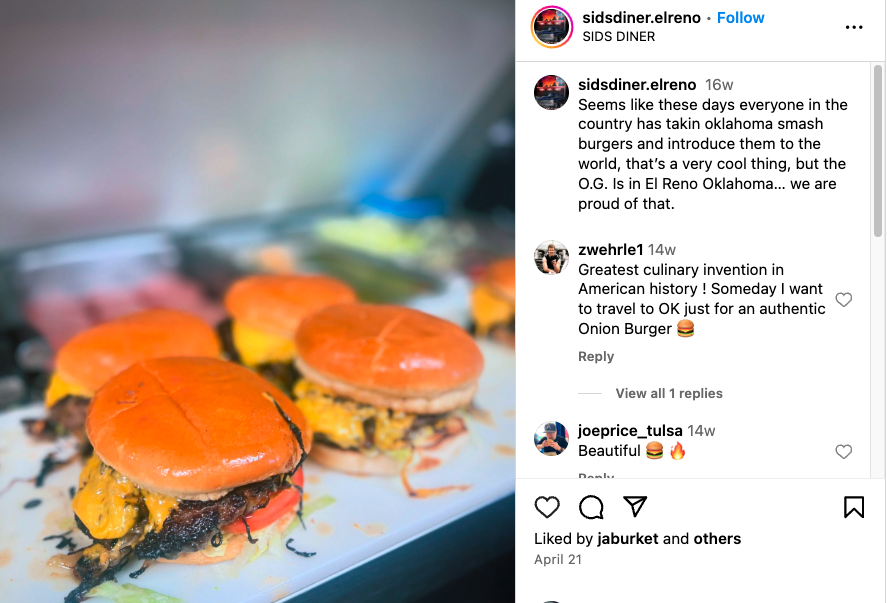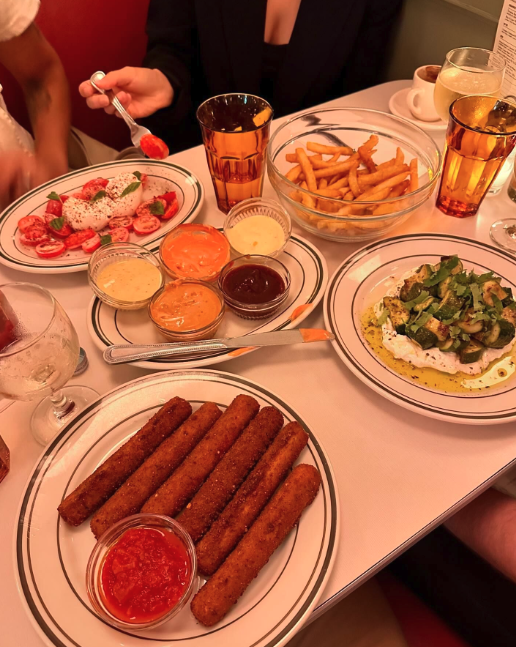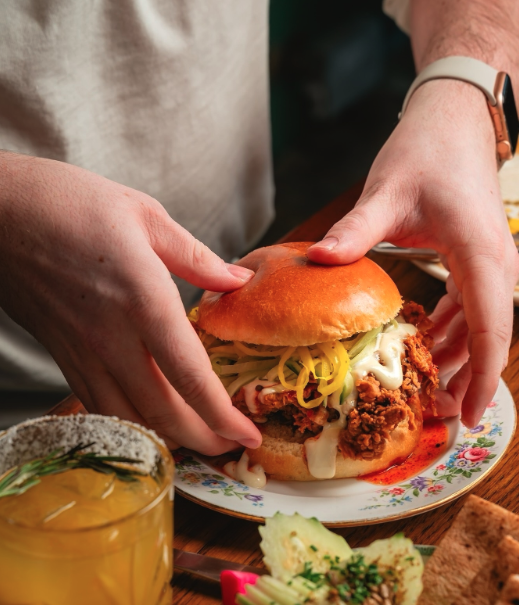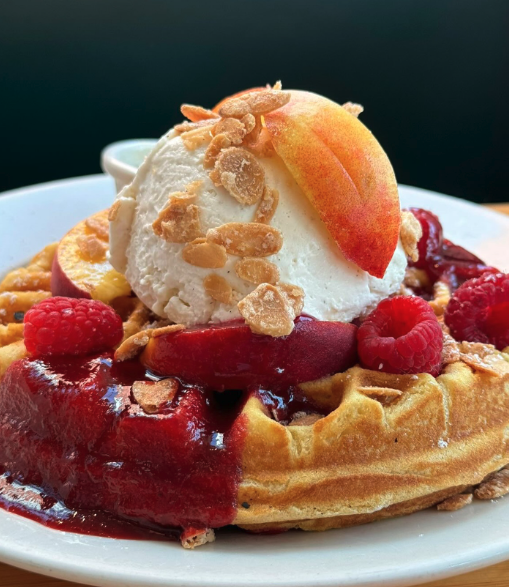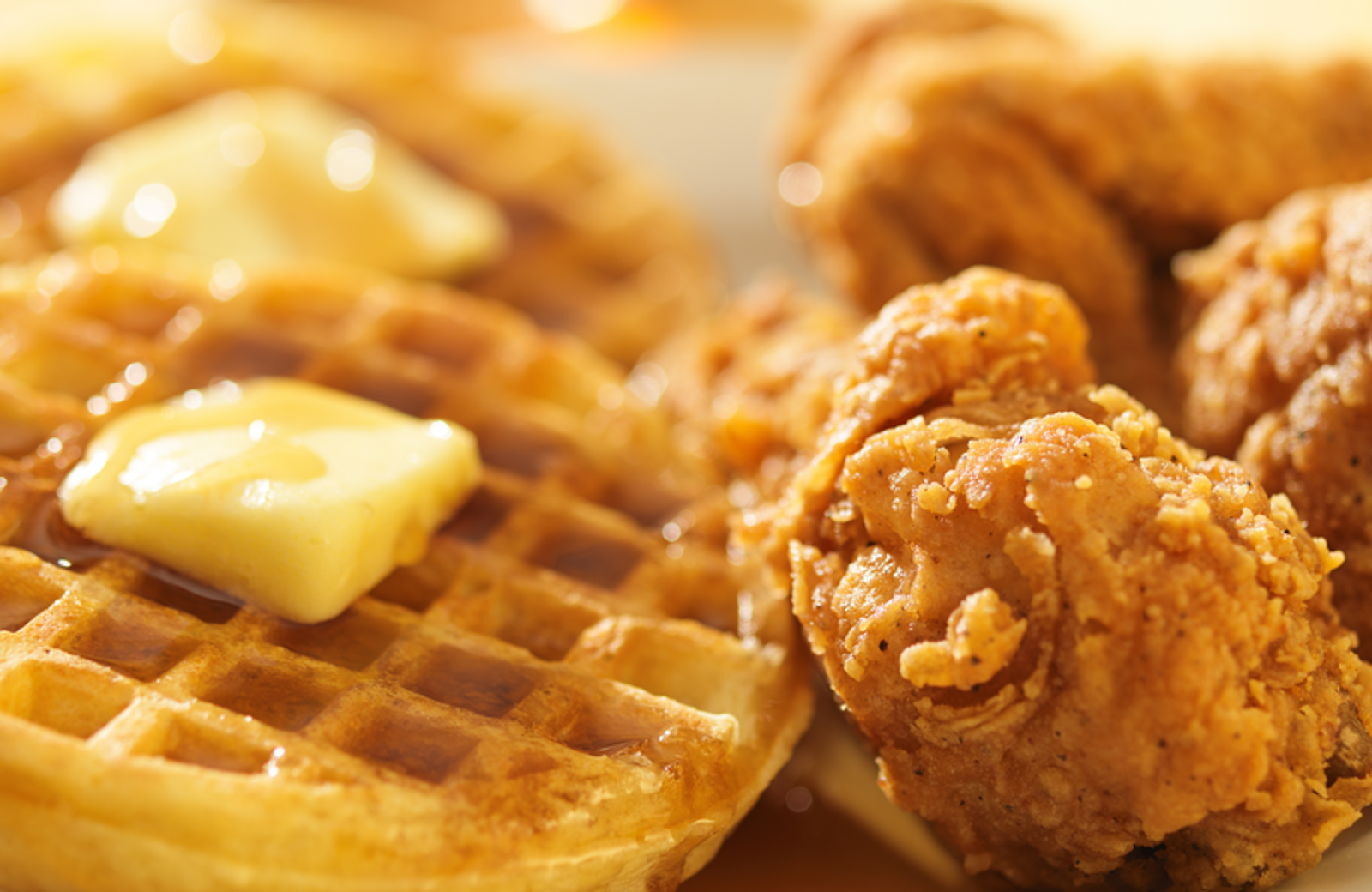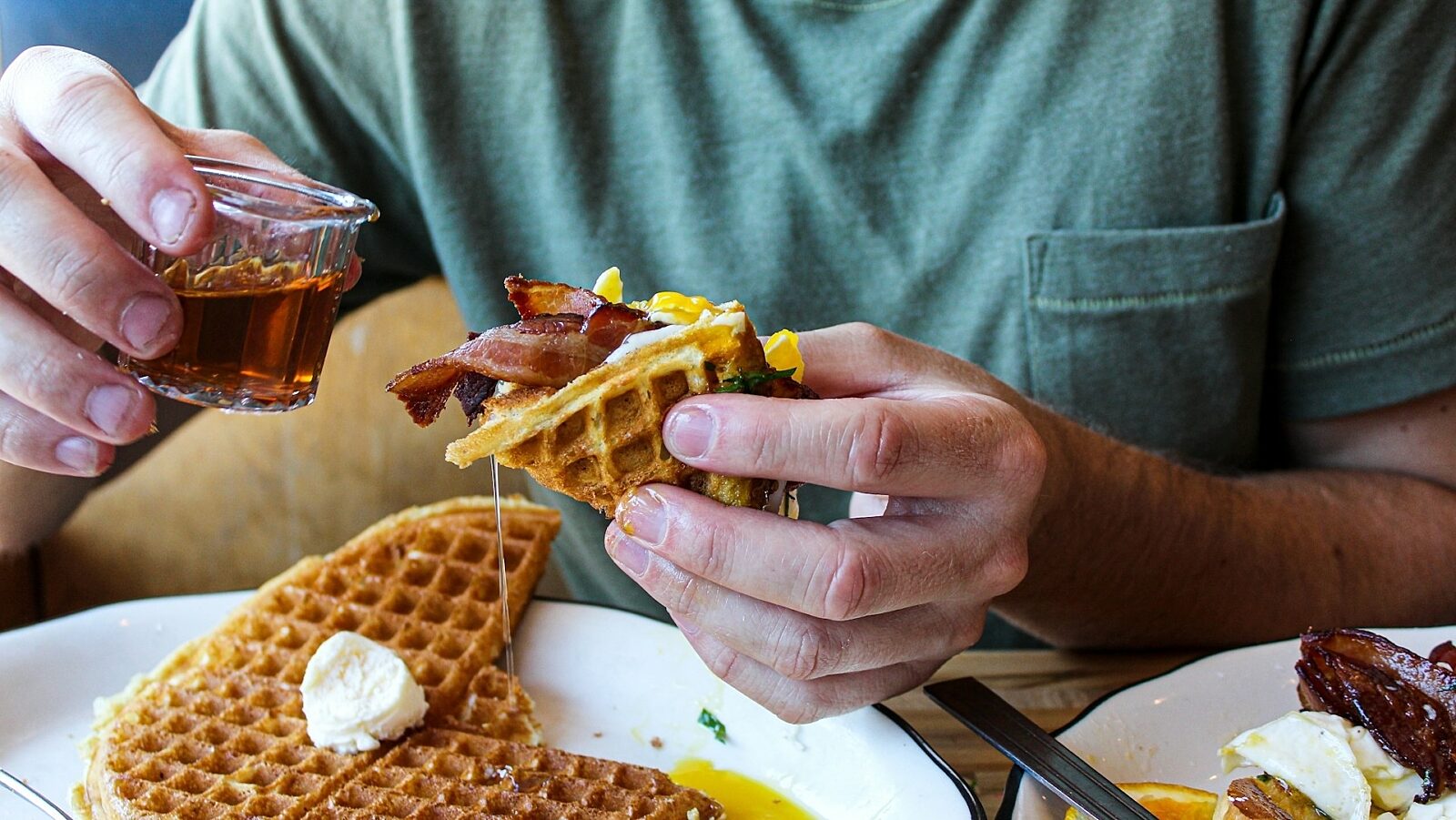
Diner Recipes: How to Develop Diner Recipes [2024]
Discover essential steps and expert tips for developing unique, high-quality recipes to make your diner a standout success.
Aidan ToborAuthor


Breakfast Menu Templates
Use these breakfast menu templates as a starting point for your menu design or to give your menu a refresh.
Get free downloadThe diner industry holds a special place in American culture, offering comfort food and a friendly, nostalgic atmosphere. In recent years, diners have seen a resurgence in popularity due to the rise of retro trends and the desire for unique, personalized dining experiences. According to Ibis World, demand for breakfast restaurants and diners has grown at a CAGR of 1.7% to $14.6 billion over the last five years, including a rise of 1.8% in 2024 alone.
The heart of a successful diner is its menu, crafted with classic, homestyle recipes that keep customers coming back. This article will guide aspiring diner owners through the key steps to develop standout recipes tailored specifically for a diner setting, ensuring both creativity and consistency.
Breakfast Menu Templates
Use these breakfast menu templates as a starting point for your menu design or to give your menu a refresh.

Step 1: Research and Inspiration
Creating exceptional diner recipes begins with thorough research and abundant inspiration.
Visit Local Diners and Food Markets
Spend time at local diners to understand what makes them successful. Observe the best-selling dishes, customer preferences, and unique twists on traditional recipes. Take note of the presentation, portion sizes, and ingredient combinations. Additionally, visit food markets to discover fresh, local ingredients that can inspire new dishes and seasonal specials.
Explore Food Trends and Popular Cuisines
Stay updated on current food trends and popular cuisines by subscribing to food industry reports and publications. Explore how these trends can be adapted to diner classics. For example, consider incorporating plant-based meats into traditional diner dishes like burgers and meatloaf to cater to health-conscious diners.
Follow Diner-Focused Food Blogs and Social Media Influencers
Follow food blogs and social media influencers who specialize in diner cuisine. Platforms like Instagram and Pinterest can provide visual inspiration and highlight emerging trends in diner food. Look for innovative takes on classic dishes, such as loaded fries with unique toppings or gourmet grilled cheese sandwiches.
Attend Food Festivals and Culinary Events
Food festivals and culinary events showcase innovative takes on classic dishes and provide networking opportunities with chefs and food enthusiasts. Attend these events to gather new ideas and insights into potential menu items for your diner. For example, a local food truck festival might inspire a new twist on a classic breakfast burrito.
Step 2: Defining Your Diner Concept
A clear and distinct concept is essential for developing a cohesive menu.
Identify Your Target Market and Their Preferences
Determine the demographics of your target market. Are they young professionals, families, retirees, or a mix? Understanding your audience will help tailor your menu to their tastes and preferences. For instance, a diner near a college campus might focus on affordable, trendy dishes, while a suburban diner might prioritize family-friendly options and comfort food classics.
Choose a Specific Cuisine or Fusion of Cuisines
Decide whether your diner will focus on traditional American fare, a specific regional cuisine, or a fusion of cuisines. For instance, you might blend Southern comfort food with classic diner staples, creating a unique menu that includes dishes like shrimp and grits alongside classic cheeseburgers.
Or for example, Golden Diner is an Asian Diner located underneath the Manhattan Bridge in Chinatown NYC that serves classic NY diner dishes that have been influenced by the neighborhood.
Determine Your Unique Selling Proposition (USP)
Identify what sets your diner apart. This could be a signature dish, a unique ingredient, or a particular cooking method. Your USP should resonate with your target market and reflect in your recipes. For example, a diner might be known for its homemade pies or its use of locally sourced, organic ingredients.
Sid’s Diner located in El Reno, OK, is known for its Oklahoma onion burger, a burger crafted with mound of thinly shaved onions that’s smashed into a beef patty as it sizzles on the griddle.
Recipe Card Template
Train your team with this recipe card template, a customizable Excel sheet that outlines recipe requirements for chefs and back of house staff.

Consider Dietary Needs and Preferences
Modern diners often cater to various dietary needs. Include vegan, gluten-free, and low-carb options on your menu to accommodate a broader customer base. Offering a variety of options ensures that all customers feel welcome and can find something they enjoy.
Step 3: Brainstorming and Initial Recipe Ideas
With your concept in mind, start brainstorming and generating initial recipe ideas.
List Potential Dishes That Fit Your Concept
Create a list of dishes that align with your diner’s theme. Think about classic diner staples like burgers, fries, milkshakes, and pancakes, and consider how you can put a unique twist on them. For instance, a diner focusing on a Southern fusion might offer chicken and waffles with a spicy maple syrup.
Despite changing ownership from Bette Kroening to long-time employees and becoming a co-op, Berkeley, California's beloved Oceanview Diner still adheres to Bette's original motto. According to SFGATE, Bette Kroening said, “[It’s] good, simple food prepared carefully … We don’t create things that have never been tried. When you order a BLT here, you’ll get a BLT that tastes better than any you have ever had because we use wonderful bread, perfect produce, bacon cooked to order and homemade mayonnaise.” This East Bay favorite has maintained its tradition for over 40 years.
Consider Seasonal Ingredients and Local Produce
Incorporate seasonal ingredients and local produce to ensure freshness and support local farmers. This approach can also inspire seasonal specials that keep your menu exciting. For example, a summer menu might feature fresh berries in desserts and salads, while a fall menu could highlight pumpkins and squash.
Think About Menu Diversity
A well-rounded diner menu should include a variety of breakfast, lunch, and dinner options, as well as sides, desserts, and beverages. This diversity caters to different tastes and keeps your offerings appealing. Ensure that you have options for different times of the day, such as hearty breakfast platters, light lunch salads, and satisfying dinner entrees.
Step 4: Recipe Development Process
Developing recipes involves a detailed and iterative process.
Start with Basic Versions of Each Dish
Begin with simple, basic versions of your dishes. Focus on nailing the fundamental flavors and techniques before experimenting with more complex variations. For example, start with a classic pancake recipe before adding unique toppings or flavorings like lemon ricotta or chocolate chip banana.
Experiment with Different Ingredients and Cooking Techniques
Test different ingredients and cooking techniques to enhance your dishes. For example, try various types of cheese for your burgers, or different batters for your pancakes. Experiment with cooking methods like grilling, roasting, and frying to find the best approach for each dish.
Focus on Balancing Flavors, Textures, and Presentation
Strive for a balance of flavors (sweet, salty, sour, bitter, umami), textures (crispy, creamy, crunchy), and presentation (plating, garnishing, portion size). A visually appealing dish with a well-rounded taste profile will leave a lasting impression. For instance, a crispy fried chicken sandwich with a tangy slaw on a soft brioche bun offers a satisfying mix of textures and flavors.
Ferns NYC has a fantastic fried chicken sandwich that features crispy fried chicken nestled between soft buns with cucumber, tangy pickled daikon, a drizzle of togarashi honey, and to top it all off, creamy ranch. Ah yes, we’ll take 14 of them!
Keep Portion Sizes and Pricing in Mind
Ensure your portion sizes are generous yet manageable, and pricing is competitive. Diners are known for offering good value, so finding this balance is crucial. Analyze your costs and set prices that ensure profitability while providing value.
Step 5: Testing and Refining Recipes
Testing and refining your recipes ensures they meet high standards.
Conduct Taste Tests with Friends, Family, and Potential Customers
Invite friends, family, and potential customers to taste your dishes. Their feedback can provide valuable insights into what works and what needs improvement. Create a feedback form to gather specific comments on flavor, texture, presentation, and overall satisfaction.
Gather Feedback on Flavor, Presentation, and Overall Appeal
Review and evaluate feedback collected on the flavor, presentation, and overall appeal of each dish. This information is essential for making necessary adjustments. Pay attention to recurring comments and be willing to make changes based on the feedback received.
Make Adjustments Based on Feedback and Retest
Use the feedback to refine and retest your recipes. This iterative process helps in achieving the perfect balance of taste and quality. For example, if testers find a dish too salty, adjust the seasoning and retest until it reaches the desired flavor profile.
Ensure Consistency in Taste and Quality
Consistency is the key to building a loyal customer base. Ensure that every serving of your dish meets the same high standards. Develop standardized recipes and train your staff to follow them precisely, ensuring that each dish is prepared and presented consistently.
SOPs Template
This template will help you create SOPs for your entire business, so you can create consistency and easily train employees.

Step 6: Sourcing Ingredients
High-quality ingredients are the backbone of great recipes.
Find Reliable Suppliers for Fresh and High-Quality Ingredients
Establish relationships with reliable suppliers who can provide fresh and high-quality ingredients consistently. Look for suppliers who share your commitment to quality and can deliver on time.
Build Relationships with Local Farmers and Markets
Supporting local farmers and markets not only ensures fresh produce but also fosters community connections and sustainability. Attend farmers' markets and build relationships with local producers to source the best ingredients for your diner.
Consider Cost-Effective Options Without Compromising Quality
While quality is paramount, it’s important to find cost-effective options. Bulk purchasing and negotiating with suppliers can help manage costs. Consider working with multiple suppliers to find the best prices without compromising on quality.
Plan for Ingredient Availability and Seasonality
Plan your menu around the availability and seasonality of ingredients to maintain quality and keep costs manageable. Create a seasonal menu that highlights the freshest ingredients available, ensuring your dishes are always at their best.
For example, Clinton Street Baking Company offers Peach Melba Waffles with fresh raspberry sauce only during the months of July and August, when peaches are their best.
Step 7: Scaling Recipes for a Diner
Scaling recipes for a diner setting requires careful planning.
Adjust Recipe Quantities for Larger Batches
Modify your recipes to accommodate larger batch sizes, ensuring that the taste and quality remain consistent. Use precise measurements and scaling techniques to maintain the integrity of each dish.
Ensure Consistency in Taste and Presentation for Every Serving
Develop a standardized process for preparing and serving each dish to maintain consistency in taste and presentation. Create detailed recipe cards and training materials for your kitchen staff to follow.
Develop a System for Efficient Prep and Cooking in the Diner
Create an efficient prep and cooking system that allows for quick service without compromising quality. This might include pre-prepping ingredients, organizing your kitchen layout for optimal workflow, and streamlining cooking processes to handle peak times effectively.
Consider Storage and Space Limitations in the Diner
Be mindful of storage and space limitations. Optimize your kitchen layout and storage solutions to ensure smooth operations. Invest in space-saving equipment and organize your pantry and fridge to maximize efficiency.
Keep Customers Coming Back for More
Developing your diner’s concept, creating unique recipes, and cooking flavorful food customers crave is essential for building a successful business. Remember that your recipes may need to evolve as your business grows, so leave room for creative inspiration and adapting to evolving restaurant trends. With a commitment to customer satisfaction, your diner will be well on its way to building a loyal fan base and standing out in a competitive landscape.
Restaurant Cost Control Guide
Use this guide to learn more about your restaurant costs, how to track them, and steps you can take to help maximize your profitability.

Related Resources
Is this article helpful?
DISCLAIMER: This information is provided for general informational purposes only, and publication does not constitute an endorsement. Toast does not warrant the accuracy or completeness of any information, text, graphics, links, or other items contained within this content. Toast does not guarantee you will achieve any specific results if you follow any advice herein. It may be advisable for you to consult with a professional such as a lawyer, accountant, or business advisor for advice specific to your situation.
Read More
Subscribe to On the Line
Sign up to get industry intel, advice, tools, and honest takes from real people tackling their restaurants’ greatest challenges.
